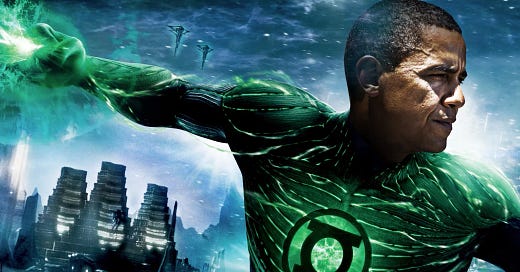The Green Lantern Theory of politics, revisited
It turns out a presidential administration can quite literally just do stuff after all. The real question is what executive power is ultimately being wielded to do.
The “Green Lantern Theory of the Presidency” is one of the most accursed memes in American political discourse — not because it corresponds to an actual theory that’s irksome, but rather because of what it’s come to signify among certain liberals. In brief: the phrase first emerged thanks to a 2014 article by Ezra Klein that straw-manned Obama critics as people who think a US president can basically do whatever they want if they simply try hard enough. The problem with this idea, for Klein, was self-evident:
Basically, it denies the very real (and very important) limits on the power of the American presidency, as well as reduces Congress to a coquettish collection of passive actors who are mostly just playing hard to get.
What was actually going on here, of course, was something else.
In 2008, America’s liberals — and a certain segment in particular — had invested themselves deeply in the belief that Barack Obama was going to transform politics and remake American society. With a charismatic and popular new president elected on the slogan Change We Can Believe In, a majority in the House of Representatives, and 60 votes in the Senate, the stars seemed perfectly aligned for the Democrats to seize the moment and enact a sweeping program of reform.
When this didn’t happen the available options were either to abandon Obama-ism or try to rationalize the glaring dissonance between the soaring rhetoric it invoked and the small-c conservative style of governance it most often embraced in practice. Some (including plenty in the millennial generation) chose the first, developing an ever-more jaundiced view of institutional liberalism and moving to the left.
But for others, a compensatory narrative quickly took hold. The problem was not, in this view, that Obama-ism was — both in the realm of ideas and in terms of personnel — much closer to Bill Clinton’s administration than to Franklin Roosevelt’s. Instead, the president’s noble ambitions had been thwarted by a mixture of conservative intransigence and institutional obstruction. The administration’s progressive critics and disenchanted supporters, proponents of this story charged, were thus asking the impossible. Whatever its limitations or disappointments might be, the Obama project was ultimately being hampered by external constraints rather than its own conservatism.
This piece isn’t really about Obama, but it’s worth underscoring the extent to which that view is belied by many of his own words and actions. In his latest memoir (I say “latest” because the man has written three and there’s somehow another on the way) he is quite open, for example, about the fact that he wasn’t really seeking to transform America’s economy or overhaul its financial system in the wake of the 2008 crash. And just as political and institutional barriers so obviously matter in politics, it matters a great deal what the people who wield power actually believe and what exactly it is they’re trying to do.
This brings us to the current occupant of the White House.
In an obvious sense, Donald Trump has no clear idea of what he’s trying to do or why. At any given time, the ideas and beliefs that guide him are a constantly shifting hodgepodge of the crackpot theories he’s exposed to by those around him, personal pettiness and self-interest, and good old-fashioned stupidity. Something that has been absolutely consistent, however, is a total lack of belief in institutional norms, procedures, or the niceties of political etiquette that are meant to go with them. Insofar as Trump is even aware of these things — by no means a given — he tends to look on them with utter contempt.
Keep reading with a 7-day free trial
Subscribe to Luke Savage to keep reading this post and get 7 days of free access to the full post archives.




